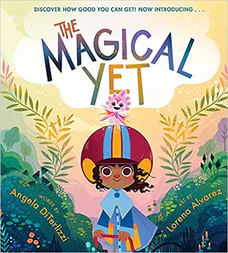The Magical Yet
Written by Angela DiTerlizzi
Illustrated by Lorena Alvarez
40 pages
•
Published 2020 (Little, Brown Books for Young Readers)

Recommended Age Range: Kindergarten through 3rd grade.
Publisher's Summary:
Each of us, from the day we’re born, is accompanied by a special companion—the Yet. Can’t tie your shoes? Yet! Can’t ride a bike? Yet! Can’t play the bassoon? Don’t worry, Yet is there to help you out. The Magical Yet is the perfect tool for parents and educators to turn a negative into a positive when helping children cope with the inevitable difficult learning moments we all face.

Dr. Annie's Takeaways
Recommended for: This beautiful book teaches about the power of “yet” when a child is feeling frustrated and discouraged (e.g., when learning a new instrument, soccer skill, math lesson, etc.). With a magical fairy-like Yet, this story teaches a child that “if you keep leaping, dreaming, wishing–waiting, learning, trying, missing/ With the Yet as your guide, along the way/ You’ll do all of the things you can’t do today.”
Would a child like it? This book is really lovely. The lyrical text is fun to read, and children will enjoy picturing their Yets cheering them along.
Evidence-Based Practices:
Cognitive Restructuring
Tone: Upbeat, inspirational
Story Quality: This lyrical, rhyming story about how the word “yet” makes anything possible really succeeds in feeling magical (“With this Yet’s magic you can begin/ to see that you’re going–beyond where you’ve been”). Yet is a cute fairy-like creature that accompanies the main character as she learns new things, like riding a bike and learning to play the kazoo.
Illustrations: The illustrations are beautiful and really make this story feel special.
Representation: The story is written with a 2nd person point-of-view, so all of the representation occurs in the illustrations. The main character is a girl with brown skin and dark brown curly hair. She rides a bike and skateboards, and she is pictured as an adult doing an engineering-type project. Many other children of diverse races, ethnicities, and genders are pictured throughout the book. For example, a girl with light brown skin and a hijab is pictured practicing tongue twisters with a White boy, and a boy with brown skin and wavy black hair is pictured practicing ballet.
Psychological Practices: In a very engaging way, this book teaches the cognitive strategy of tacking on the word “yet” when one is feeling frustrated about not being able to do something (yet). The value of adding “yet” is that it can help a child to feel less stuck and to provide hope for the future. It can also remind a child that their patience and practice will pay off. In this story, the Yet is pictured as a magical fairy-type creature who “doesn’t mind warm-ups, fixes, and flops, do-overs, re-dos, stumbles, and stops” and who helps a child to find a way to their dreams. It’s a beautiful message about how we’re all constantly growing. It would be fun to follow up a reading of this story by encouraging a child to draw their own Yet that they could picture when they’re feeling discouraged.
Concerns: None
